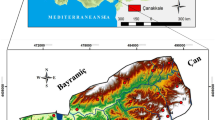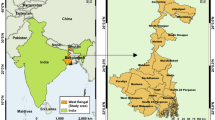Abstract
To decrease the human influence on natural resources and to recognize a suitable land use, it is vital to carry out scientific land assessments. In the present study, an attempt has been made to delineate the suitable land area for rice cultivation in the Hinglo river basin. The laboratory test data and field work observations have been combined in a geographical information system (GIS) environment. The Different environmental parameters, viz. climatic factors (temperature and precipitation), topographic factors (slope and relief), hydro-geomorphological factors (distance from river, depth of the groundwater and geology), physical properties of soil (soil texture and soil depth) and chemical properties of soil (pH, boron, copper, nitrogen, iron, manganese, phosphorous, potassium, sulphur, zinc etc.) have been used. Each thematic layer has been assigned the rating by analytical hierarchical process method. With the help of weighted overlay method, all thematic layers have been converted into a single layer to prepare the suitability map for rice cultivation in GIS environment. The entire basin has been classified into four suitable classes namely ‘highly suitable’; ‘moderate suitable’, ‘marginally suitable’, and ‘not suitable’ land area. Only 10.88% of the total area is most suitable for rice cultivation. The western and north-middle portion of this watershed region is not suitable for rive cultivation because of the extreme climatic condition, rugged topographic, and lack of proper soil micronutrients. The lower portion of this watershed is most suitable for the rice cultivation due to presence of newer alluvium soil, lower sloping area and abundance of soil micronutrient.



Source: prepared by authors

Source: prepared by authors

Source: prepared by authors


Source: prepared by authors

Source: prepared by authors
Similar content being viewed by others
References
Akinci H, Ozalp AY, Turgut B (2013) Agricultural land use suitability analysis using GIS and AHP technique. Comput Electron Agric 97:71–82. https://doi.org/10.1016/j.compag.2013.07.006
Althuwaynee OF, Pradhan B, Park HJ, Lee JH (2014) A novel ensemble bivariate statistical evidential belief function with knowledge-based analytical hierarchy process and multivariate statistical logistic regression for landslide susceptibility mapping. Catena 114:21–36. https://doi.org/10.1016/j.catena.2013.10.011
Bagchi K, Mukherjee KN (1983) Diagnostic Survey of West Bengal(s) Dept. of Geography, Calcutta University, Delta & Rarh Bengal. Department of Geography, Calcutta University, pp 17–19, pp 42–58
Bandyopadhyay S, Jaiswal RK, Hegde VS, Jayaraman V (2009) Assessment of land suitability potentials for agriculture using a remote sensing and GIS based approach. Int J Remote Sens 30(4):879–895. https://doi.org/10.1080/01431160802395235
Barakat A, Ennaji W, Jazouli AE, Amediaz R, Touhami F (2017) Multivariate analysis and GIS-based soil suitability diagnosis for sustainable intensive agriculture in Beni-Moussa irrigated sub-perimeter (Tadla plain, Morocco). Model Earth Syst Environ. https://doi.org/10.1007/s40808-017-0272-5
Cengiz T, Akbulak C (2009) Application of analytical hierarchy process and geographic information systems in land-use suitability evaluation: a case study of Dumrek village. Int J Sustain Dev World Ecol 16(4):286–294. https://doi.org/10.1080/13504500903106634
Chakravarty SC (1970) In: Chattopadhyay B (ed) Some Consideration on the evolution of physiography of Bengal, in West Bengal. Geog. Instt. Presidency College. Calcutta, p 20
Chandio IA, Matori AN, Lawal DU, Sabri S (2011) GIS-based land suitability analysis using AHP for public parks planning in Larkana City. Mod Appl Sci 5(4):177–189. https://doi.org/10.5539/mas.v5n4p177
Daneshvar MR, Khatami F, Shirvani S (2017) GIS-based land suitability evaluation for building height construction using an analytical process in the Mashhad city, NE Iran. Model Earth Syst Environ. https://doi.org/10.1007/s40808-017-0286-z
Deep S, Saklani A (2014) Urban sprawl modeling using cellular automata. Egypt J Remote Sens Space Sci 17(2):179–187. https://doi.org/10.1016/j.ejrs.2014.07.001
Duc TT (2006) Using GIS and AHP technique for land-use suitability analysis. In: International symposium on geo informatics for spatial infrastructure development in earth and allied sciences, pp 1–6
FAO (1976) A framework for land evaluation, Soil Bulletin 32. Food and agriculture organization of the United Nations, Rome
Fattahi H, Farsangi MAE, Shojaee S, Mansouri H (2014) Selection of a suitable method for the assessment of excavation damage zone using fuzzy AHP in Aba Saleh Almahdi tunnel, Iran. Arab J Geosci. https://doi.org/10.1007/s12517-0141280-7
Feizizadeh B, Blaschke T (2013) Land suitability analysis for Tabriz County, Iran: a multi criteria evaluation approach using GIS. J Environ Plan Manag 56(1):1–23. https://doi.org/10.1080/09640568.2011.646964
Garcia JL, Alvarado A, Blanco J, Jimenez E, Maldonado AA, Corte´s G (2014) Multi-attribute evaluation and selection of sites for agricultural product warehouses based on an analytic hierarchy process. Comput Electron Agric 100:60–69. https://doi.org/10.1016/j.compag.2013.10.009
Ghosh KG, Shah S (2015) Identification of soil erosion susceptible areas in Hinglo river basin, Eastern India based on geo-statistics. Uni J Environ Res Technol 5(3):152–164
GSI (1985) Geological quadrangle map, Bardhhaman Quadrangle (73M), West Bengal Bihar Geological Survey of India, Printing Div. Hyderabad, Govt. of India
Hopkins L (1977) Methods for generating land suitability maps: a comparative evaluation. J Am Inst Plan 43(4):386–400. https://doi.org/10.1080/01944367708977903
Jafari S, Zaredar N (2010) Land suitability analysis using multi-attribute decision making approach. Int J Environ Sci Dev 1(5):441–445. https://doi.org/10.7763/ijesd.2010.v1.85
Javadian M, Shamskooshki H, Momeni M (2011) Application of sustainable urban development in environmental suitability analysis of educational land use by using AHP and GIS in Tehran. Proc Eng 21:72–80. https://doi.org/10.1016/j.proeng.2011.11.1989
Joerin F, Theriault M, Musy A (2001) Using GIS and outranking multi-criteria analysis for land-use suitability assessment. Int J Geogr Inform Sci 15(2):153–174. https://doi.org/10.1080/13658810051030487
Jothibasu A, Anbazhagan S (2016) Modeling groundwater probability index in Ponnaiyar river basin of South India using analytic hierarchy process. Model Earth Syst Environ. https://doi.org/10.1007/s40808-016-0174-y
Kaliraj S, Chandrasekar N, Magesh NS (2013) Identification of potential groundwater recharge zones in Vaigai upper basin, Tamil Nadu, using GIS-based analytical hierarchical process (AHP) technique. Arab J Geosci. https://doi.org/10.1007/s12517-013-0849-x
Malczewski J (2004) GIS-based land suitability: a critical over view. Progr Plan 62(1):3–65. https://doi.org/10.1016/j.progress.2003.09.002
Malczewski J (2006) GIS-based multi-criteria decision analysis: a survey of the literature. Int J Geogr Inf Sci 20(7):703 726
Mendas A, Delali A (2012) Integration of multi-criteria decision analysis in GIS to develop land suitability for agriculture: application to durum wheat cultivation in the region of Mleta in Algeria. Comput Electron Agric 83:117–126. https://doi.org/10.1016/j.compag.2012.02.003
Miller W, Collins W, Steiner FR, Cook E (1998) An approach for greenway suitability analysis landscape and urban planning. Int J Geogr Inf Sci 42(2–4):91–105. https://doi.org/10.1016/s0169-2046(98)00080-2
Mokarram M, Aminzadeh F (2010) GIS-based multi-criteria land suitability evaluation using ordered weight averaging with fuzzy quantifier: a case study in Shavur Plain, Iran. Int Arch Photogram Remote Sens Spat Inf Sci 38(2):508–512
Mukherjee A, Fryer AE, Howell P (2007) Regional hydro-stratigraphy and ground waterflow modeling of the arsenic contaminated aquifers of the western Bengal basin, West Bengal, India. Hydro J 15:1397–1418. https://doi.org/10.1007/s10040-007-0208-7
NATMO (2001) National Atlas and Thematic Mapping Organization, District Planning Map Series (DST), Digital Mapping and Printed Division, Kolkata
Navarro EM, Martínez-Pérez S, Sastre-Merlín A, Bienes-Allas R (2014) Catchment erosion and sediment delivery in a limno-reservoir basin using a simple methodology. Water Resour Manag 28:2129–2143. https://doi.org/10.1007/s11269-014-0601-7
OECD (2016) Consensus document on compositional considerations for new varieties of rice (Oryza sativa): key food and feed nutrients, anti-nutrients and other constituents Environment Directorate, Joint Meeting of the Chemicals Committee and the Working Party on Chemicals, Pesticides and Biotechnology. Series on the Safety of Novel Foods and Feeds, No. 28, ENV/JM/MONO (2016)38. http://www.oecd.org/science/biotrack/ consensus-document-for-work on-safety-novel and-foods-feeds plants.htm.Accessed 7 Oct 2016
Owusu S, Mul ML, Ghansah B, Osei-Owusu PK, Awotwe-Pratt V, Kadyampakeni D (2017) Assessing land suitability for aquifer storage and recharge in northern Ghana using remote sensing and GIS multi-criteria decision analysis technique. Model Earth Syst Environ 3(4):1383–1393. https://doi.org/10.1007/s40808-017-0360-6
Pazand K, Hezarkhani A, Ghanbari Y (2014) Fuzzy analytical hierarchy process and GIS for predictive Cu porphyry potential mapping: a case study in Ahar–Arasbaran Zone (NW, Iran). Arab J Geosci 7(1):241–251. https://doi.org/10.1007/s12517-012-0774-4
Pourghasemi HR, Pradhan B, Gokceoglu C (2012) Application of fuzzy logic and analytical hierarchy process (AHP) to landslide susceptibility mapping at Haraz watershed, Iran. Nat Hazards 63(2):965–996. https://doi.org/10.1007/s11069-012-0217-2
Pramanik MK (2016) Site suitability analysis for agricultural land use of Darjeeling district using AHP and GIS techniques. Model Earth Syst Environ. https://doi.org/10.1007/s40808-016-0116-8
Rahaman SA, Aruchamy S (2017) Geoinformatics based landslide vulnerable zonation mapping using analytical hierarchy process (AHP), a study of Kallar river sub watershed, Kallar watershed, Bhavani basin, Tamil Nadu. Model Earth Syst Environ. https://doi.org/10.1007/s40808-017-0298-8
Ray A, Shekhar S (2009) Ground water issues and development strategies in West Bengal. Bhu-Jal News 24(1):1–17
Roig-Tierno N, Baviera-Puig A, Buitrago-Vera J, Mas-Verdu F (2013) The retail site location decision process using GIS and the analytical hierarchy process. Appl Geogr 40:191–198. https://doi.org/10.1016/j.apgeog.2013.03.005
Saaty TL (1980) The analytic hierarchy process: planning, priority setting, resource allocation. McGraw Hill International, New York
Saaty TL (1990) The analytic hierarchy process: planning, priority setting, resource allocation, 1st edn. RWS Publications, Pittsburgh, p 502
Saaty TL (1994) Fundamentals of decision making and priority theory with analytic hierarchy process, 1st edn. RWS Publications, Pittsburgh, p 527
Saaty TL, Vargas LG (2001) Models, methods, concepts, and applications of the analytic hierarchy process, 1st edn. Kluwer Academic, Boston, p 333
Shalaby A, Ouma YO, Tateishi R (2006) Land suitability assessment for perennial crops using remote sensing and geographic information systems: a case study in North-western Egypt. Arch Agron Soil Sci 52(3):243–261
Steiner F, McSherry L, Cohen J (2000) Land suitability analysis for the upper Gila River watershed. Landsc Urban Plan 50:199–214. https://doi.org/10.1016/s0169-2046(00)00093-1
Triantaphyllou E, Mann SH (1995) Using the analytic hierarchy process for decision making in engineering applications: some challenges. Int J Ind Eng Appl Pract 2(1):35–44
Wang F (1994) The use of artificial neural networks in a geographical information system for agricultural land-suitability assessment. Environ Plan A 26(2):265–284. https://doi.org/10.1068/a260265
Wu Q, Wang M (2007) A framework for risk assessment on soil erosion by water using an integrated and systematic approach. J Hydrol 337(1–2):11–21. https://doi.org/10.1016/j.jhydrol.2007.01.022
Xu Y, Sun J, Zhang J, Xu Y, Zhang M, Liao X (2012) Combining AHP with GIS in synthetic evaluation of environmental suitability for living in China’s 35 major cities. Int J Geogr Inf Sci 26(9):1603–1623. https://doi.org/10.1080/13658816.2011.642800
Yalew SG, Griensven AV, Mul ML, Zaag PV (2016) Land suitability analysis for agriculture in the Abbay basin using remote sensing, GIS and AHP techniques. Model Earth Syst Environ. https://doi.org/10.1007/s40808-016-0167-x
Youssef MA, Pradhan B, Tarabees E (2011) Integrated evaluation of urban development suitability based on remote sensing and GIS techniques: contribution from the analytic hierarchy process. Arab J Geosci 4:463–473. https://doi.org/10.1007/s12517-009-0118-1
Zolekar RB, Bhagat VS (2014) Use of IRS P6 LISS-IV data for land suitability analysis for cashew plantation in hilly zone. Asian J Geoinform 14(3):23–35
Acknowledgements
The author would like to thanks to Agricultural Chemist, Soil Testing Laboratory, Malda, West Bengal, India for helping the soil sample test. Additionally, author would like to acknowledge all the agencies specially, geological survey of India, Central Ground Water Board Ministry of Water Resources Government of India, National Bureau of Soil Survey and Land Use Planning, Indian Metrological Department, survey of India and USGS for obtaining the maps required for the study.
Author information
Authors and Affiliations
Corresponding author
Electronic supplementary material
Below is the link to the electronic supplementary material.
Rights and permissions
About this article
Cite this article
Roy, J., Saha, S. Assessment of land suitability for the paddy cultivation using analytical hierarchical process (AHP): a study on Hinglo river basin, Eastern India. Model. Earth Syst. Environ. 4, 601–618 (2018). https://doi.org/10.1007/s40808-018-0467-4
Received:
Accepted:
Published:
Issue Date:
DOI: https://doi.org/10.1007/s40808-018-0467-4




